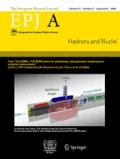Abstract:
Gamma rays from excited states of 190Po have been observed using the Jurosphere Ge-detector array coupled to the RITU gas-filled separator. They were associated with a collective band which from spin 4 onwards resembles the prolate rotational bands known in the isotones 188Pb and 186Hg. This indicates that in 190Po the prolate configuration becomes yrast above I = 2. The experimental results are interpreted in a two-band mixing calculation and are in agreement with α-decay data and potential energy surface calculations.
Similar content being viewed by others
Author information
Authors and Affiliations
Additional information
Received: 10 January 2003 / Accepted: 19 February 2003 / Published online: 7 May 2003
Rights and permissions
About this article
Cite this article
Van de Vel, K., Andreyev, A., Page, R. et al. In-beam γ-ray spectroscopy of 190Po: First observation of a low-lying prolate band in Po isotopes. Eur Phys J A 17, 167–171 (2003). https://doi.org/10.1140/epja/i2003-10002-x
Issue Date:
DOI: https://doi.org/10.1140/epja/i2003-10002-x


